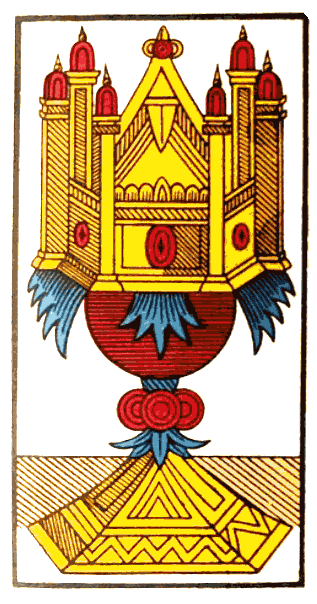synthetic meaning
The cup implies passivity in passivity because it deals with a man's interior work involving himself.
With its red-colored cup, the Ace symbolizes symbolizes a receptivity on the plane of material activity, grounded in the intelligence of the ternary, the fulcrumof the worlds (the yellow color of the triangle pedestal) and receptacle of divine thought made concrete in the tangible image of of a reliquary.
This arrangement shows that the Cup is the point where the spiritual and the material come into contact with each other. This communion is symbolized by the red semicircle representing the Host; and the cup, concealing its contents, indicates the internal work which is accomplished in everything to balance in itself that which it was able to retain of the riches of divine love with the achievements accomplished in the material world. This internal work permits man to become aware of himself by means of the imagination and sensibility, the one being the point of contact of the soul with the spiritual plane through mysticism, the other being basic awareness with matter.
The Cup, by what it contains, will always suggest an internal elaboration, hidden in passivity and in the uncertainty of action.
analytic meaning
The cup has been selected as a symbol of an essentially-receptive passivity because i is a recipient which, with its covering, becomes a sphere, which is to say, a closed receptacle, maintaining its internal forces and permitting their development in isolation.
The Ace of Cups opens the door for clearing the mind and for the internal feeling of riches and the things which have been acquired by Being on the different planes of the animistic, spiritual riches dressing up in matter and entering into the sensitivity with which it animates the different planes.
This card represents spiritual thought transposed onto a concrete form. It is represented in the shape of a cup to show that Man is able to be enveloped and absorbed by his higher mind. This is surmounted by a construction in the shape of a reliquary or a symbol of the Grail, signifying that the spiritual contribution of the divine is a kind of wealth which is able to be contained and protected, because all divine thought made concrete which is scattered does not reach its goal and does not bear fruit. Its gold color, as well as its base and the central part, red, bringing them together, indicates a polarization between the High and the low; the Divine Intelligence descends, by a communion, into the base of beings and things, after having crossed through matter, but as the reliquary it is larger than the base, that which predominates is the spiritual.
The red cup supports the septenary indicated by the seven yellow turrets which, with their seven red summits, shows through the number 7 that the elevation of Man must be established by all the ranges of vibration of the soul, expressed in the highest part of the material plane.
The central motif of the highest part, in the shape of an ogive surmounted by three balls, and a triangle above, brings to mind the universal intelligence which builds on the perfection of the triangle, a symbol of the Trinity.
The three blue spurts make manifest the psychic momentum which rushes towards matter, while the later marks the momentum towards the High, first by its three red ovals at the base of the reliquary, then by the red extremities of the 7 columns. This momentum thus shows its manifestation in the three worlds, then its expansion in the Universal, by the activity of the septenary.
The base, by its ternary shape, bearing a triangle and four waves on one of its sides, recalls the quartenary within the ternary, evoking also the latent state of the number 7 which will find itself fulfilled in the 7 elevations of the reliquary.
The blue color of the mount indicates spiritual support, existing before all communion; this cannot take place without it. The five blue leaves at the base are a symbol of activity and affectivity at the Spiritual level (the 5 indicates a vibrational note within an activity).
The ground, partially flesh colored [sic] and striped with black lines, and partially white, specifies that this animistic cup rests as much on the vital activities of the physical plane as it does on the light of the abstract plane.
meanings as they relate to the three planes
This card maintains a rapport with the Universal, because it is based on the septenary and essentially on the ternary. It is a powerful spiritual contribution, a great psychic protection. It does not descend into the into the individual anima like maternal love, but it maintains itself in the higher planes.
The cups are in rapport with altruism and spiritual offerings, and the Ace of Cups, through itself, opens the doors for engagement with the spirit.
MENTAL. Clear, inspired judgement, against which there is no turning back.
ANIMISTIC. Beauty of feelings, rising above a personal note. Altruism, works of charity. Mass education.
PHYSICAL. In contact with the higher things of the material world. Great enterprises. Artistic productions of genius.
INVERTED [1]. Protection is not withdrawn, but its effects are less felt and is unknon to the person who receives it. Being deprives itself of matter and loses all spirituality. Gross materialism.
In its elementary sense, the Ace of Cups represents in Man the internal development of riches acquired on all planes of the anima.
1. In general, the Cup cards inverted signify that the readings which concern the physical plane are accomplished almost without remission. The upright cup represents plentitude and, inverted, the inability to receive.
